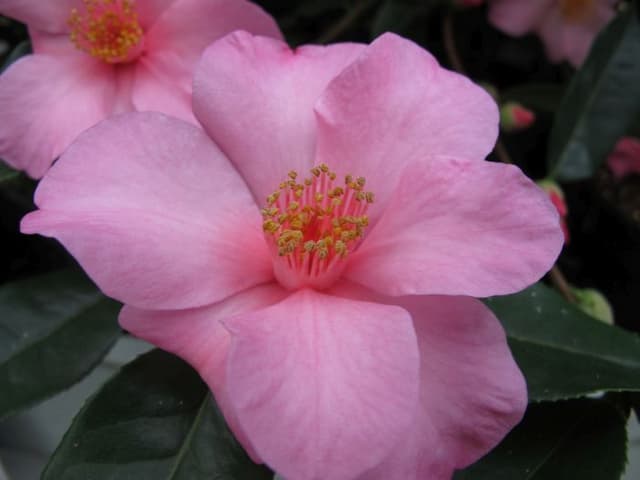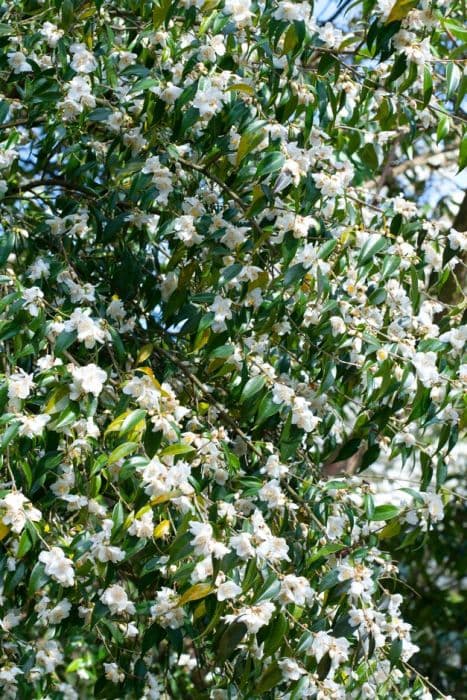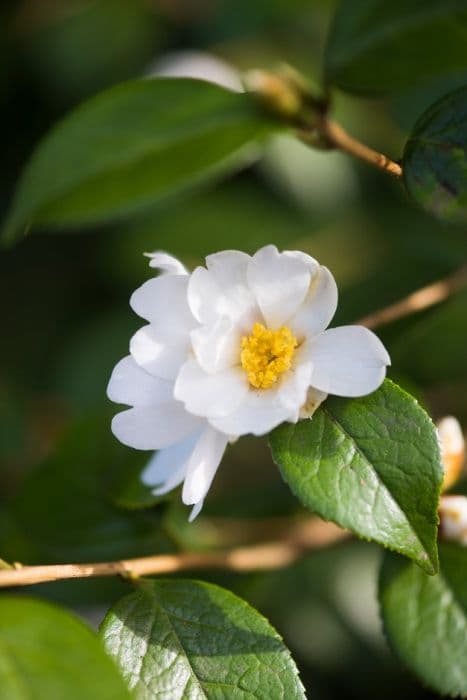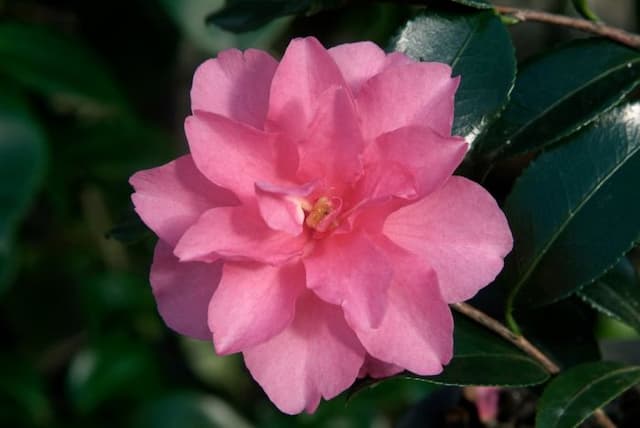Williamsii Camellia Camellia × williamsii 'Water Lily'

ABOUT
The Water Lily is a plant admired for its beautiful flowers and lush foliage. Its blossoms are the highlight, characterized by a delicate texture, and they typically flaunt a pleasing pink hue. The flowers can be likened to water lilies in shape, which is where it gets its name—hence, they are broad, ruffled, and comprised of multiple layers of petals. The middle of the flower sports a cluster of prominent, contrasting yellow stamens. The leaves of the Water Lily are also visually pleasing. They grow in an attractive, glossy green shade with an ovate shape and have a leathery texture. The foliage provides a lustrous backdrop that accentuates the flowers. In bloom, the Water Lily becomes a spectacular display, with its flowers set against the evergreen foliage, making it an excellent addition to gardens for ornamental purposes. The plant exudes an air of elegance and tranquility, which is befitting given its association with the serene beauty of actual water lilies floating on a pond.
About this plant
 Names
NamesFamily
Theaceae
Synonyms
Williamsii Camellia, Water Lily Camellia
Common names
Camellia × williamsii 'Water Lily'.
 Toxicity
ToxicityTo humans
The Williamsii Camellia, commonly known as Camellia, is generally not considered toxic to humans. There are no significant reports or authoritative sources indicating that it causes poisoning when ingested or touched. Therefore, if someone were to ingest a part of the Camellia plant, they would not be expected to exhibit symptoms of poisoning solely due to the plant's toxicity.
To pets
The Williamsii Camellia is not known to be toxic to pets such as dogs and cats. This plant does not appear on the lists of toxic plants maintained by key animal health organizations. Therefore, if a pet ingests parts of the Camellia plant, they are not likely to experience symptomatic poisoning attributable to this specific plant's toxicity. However, individual animals might have different sensitivities or allergic reactions, so monitoring and caution are always recommended when pets ingest any non-food plants.
 Characteristics
CharacteristicsLife cycle
Perennials
Foliage type
Evergreen
Color of leaves
Green
Flower color
Pink
Height
6-10 feet (1.8-3 meters)
Spread
6-10 feet (1.8-3 meters)
Plant type
Shrub
Hardiness zones
7-9
Native area
Asia
Benefits
 General Benefits
General Benefits- Aesthetic Appeal: Adds color and visual interest to gardens with its large, water lily-like double flowers that are typically pink in color.
- Landscape Versatility: Can be used in a variety of landscape designs, including as a specimen plant, in mixed borders, or as foundation plantings.
- Long Flowering Period: Blooms in late winter to early spring, providing color and beauty during a time when few other plants are flowering.
- Evergreen Foliage: Provides year-round interest with its glossy, dark green leaves, even when not in bloom.
- Attracts Pollinators: Supports local ecosystems by attracting bees and other pollinating insects during its flowering season.
- Shade Tolerance: Thrives in part shade, making it suitable for planting under taller trees or in slightly shaded areas of a garden.
- Ease of Care: Generally low-maintenance, requiring minimal pruning and care once established.
 Medical Properties
Medical PropertiesThis plant is not used for medical purposes.
 Air-purifying Qualities
Air-purifying QualitiesThis plant is not specifically known for air purifying qualities.
 Other Uses
Other Uses- Pressed Flower Art: The blossoms of Camellia 'Water Lily' can be pressed and used in crafting beautiful, natural art pieces and decorations for greeting cards or bookmarks.
- Floral Arrangements: Fresh or dried, the flowers serve as an ornamental addition to bouquets and floral arrangements due to their beauty and form.
- Photography Subject: Camellia 'Water Lily' makes an excellent subject for botanical photography thanks to its striking flowers and foliage.
- Wedding Decor: The elegant blooms can be integrated into wedding decorations, including table centerpieces or as part of the bridal bouquet.
- Fabric Dyeing: Petals from the Camellia 'Water Lily' can potentially be used to create natural dyes for coloring fabrics.
- Educational Tool: The plant can serve as a model in horticultural studies for topics such as plant hybridization and breeding practices.
- Culinary Decoration: Though not typically consumed, the flowers can be used as edible decorations on cakes and pastries after making sure they have not been treated with chemicals.
- Perfumery: While Camellia 'Water Lily' is not known for a strong scent, its oil can be infused into mild fragrances or used as a base in perfume making.
- Horticultural Therapy: Caring for Camellia 'Water Lily' can be therapy for individuals, offering a calming activity for those with mental health challenges.
- Feng Shui: In some cultures, Camellia 'Water Lily' is believed to bring good luck and positive energy when planted in certain areas of a garden or home.
Interesting Facts
 Feng Shui
Feng ShuiCamellia is not used in Feng Shui practice.
 Zodiac Sign Compitability
Zodiac Sign CompitabilityCamellia is not used in astrology practice.
 Plant Symbolism
Plant Symbolism- Admiration: Camellia Water Lily is often associated with deep admiration for someone, expressing esteem and fascination.
- Perfection: The symmetry and beauty of the Camellia Water Lily blooms convey a message of perfection, making it suitable to acknowledge someone's flawless nature.
- Love: Different colors of Camellia, including Water Lily, can symbolize various aspects of love. The plant as a whole is often seen as a representation of romantic desire.
- Longevity: With its sturdy nature and evergreen foliage, Camellia Water Lily symbolizes a wish for long life and steadfastness.
- Gratitude: Presenting someone with a Camellia Water Lily can be an expression of gratitude, symbolizing thankfulness and appreciation.
 Water
WaterWilliamsii camellias, including the 'Water Lily' variety, should be watered thoroughly whenever the top inch of soil feels dry, which typically means once a week. During the growing season, in spring and summer, increase watering frequency to maintain consistent soil moisture. Provide about 1 to 1.5 gallons of water each time to ensure deep watering that reaches the root zone. In the winter months, reduce watering as the plant’s growth slows down. Always use lukewarm water to avoid shocking the plant's roots.
 Light
LightWilliamsii camellias like the 'Water Lily' prefer dappled sunlight or partial shade. They thrive best when sheltered from the intense afternoon sun, so planting them in an eastern or northern exposure is ideal. Bright, indirect light will promote healthy growth and flowering without causing sunburn to the foliage.
 Temperature
TemperatureWilliamsii camellias such as 'Water Lily' are hardy in USDA zones 7 to 9 and can tolerate minimum temperatures down to 5 degrees Fahrenheit. However, they perform best in temperatures ranging between 40 to 85 degrees Fahrenheit. Protect the plant from frost to avoid damage to the buds and flowers.
 Pruning
PruningPrune 'Water Lily' Williamsii camellias to maintain shape, remove crossing branches, and encourage airflow. The best time to prune is just after blooming in late winter or early spring before new growth begins. Prune minimally, once annually, as Williamsii camellias don't require heavy pruning unless they are being trained for a particular shape.
 Cleaning
CleaningAs needed
 Soil
SoilCamellia 'Water Lily' thrives in well-draining, acidic soil with a pH of 5.0 to 6.5. A mix of 1/3 pine bark, 1/3 peat moss, and 1/3 perlite or coarse sand is ideal.
 Repotting
RepottingCamellia 'Water Lily' should be repotted every 2-3 years, ideally in the spring after blooming, to provide fresh nutrients and encourage growth.
 Humidity & Misting
Humidity & MistingCamellia 'Water Lily' prefers a humidity level of 40-60%, which mimics its native environment and supports lush foliage and bloom development.
 Suitable locations
Suitable locationsIndoor
Place Camellia 'Water Lily' near a window for filtered light, keep soil moist.
Outdoor
Plant Camellia 'Water Lily' in filtered sunlight, sheltered from strong winds.
Hardiness zone
7-9 USDA
 Life cycle
Life cycleCamellia × williamsii 'Water Lily' begins its life cycle as a seed, germinating in moist, well-drained soil, preferably in partial shade. The seedling stage follows, during which it develops a root system and its first true leaves. As the plant enters the vegetative stage, it grows larger, producing more leaves and branches to form a bushy structure. This is followed by the flowering stage, typically occurring in late winter or spring, where the plant produces its characteristic large, showy flowers that range from pink to white. After pollination, the plant develops seed pods, which eventually ripen and release seeds to start the next generation. Finally, the Camellia enters a period of dormancy, with reduced metabolic activity during colder months before the cycle begins anew with the subsequent flowering season.
 Propogation
PropogationPropogation time
Spring
The Camellia × williamsii 'Water Lily', commonly known as Camellia 'Water Lily', is often propagated through semi-hardwood cuttings. This technique is typically undertaken in late summer after the new growth has begun to harden. Cuttings should be about 4 to 6 inches long and include several leaf nodes. The lower leaves are removed, and the cut end of the cutting is often treated with a rooting hormone to encourage root development. Cuttings are then inserted into a well-draining rooting medium, such as a mixture of peat and perlite, and kept under high humidity and indirect light until roots have developed, which usually takes several months. It's important to keep the medium consistently moist but not overly wet to prevent rot. Once the cuttings have rooted, they can be potted up and gradually acclimated to less humid conditions before eventual planting out.









